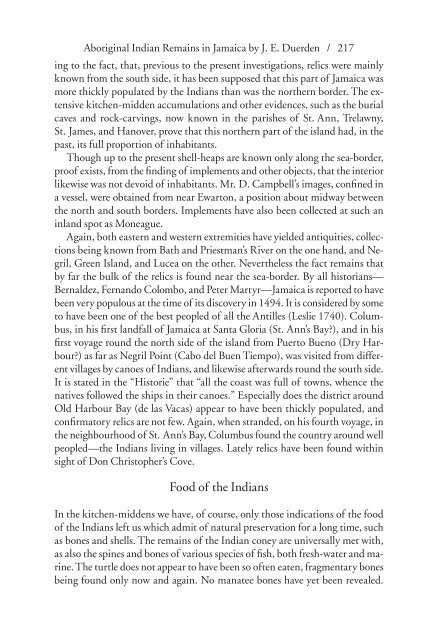Pre-Colombian Jamaica: Caribbean Archeology and Ethnohistory
by Phillip Allsworth-Jones
by Phillip Allsworth-Jones
You also want an ePaper? Increase the reach of your titles
YUMPU automatically turns print PDFs into web optimized ePapers that Google loves.
Aboriginal Indian Remains in <strong>Jamaica</strong> by J. E. Duerden / 217<br />
ing to the fact, that, previous to the present investigations, relics were mainly<br />
known from the south side, it has been supposed that this part of <strong>Jamaica</strong> was<br />
more thickly populated by the Indians than was the northern border. The extensive<br />
kitchen- midden accumulations <strong>and</strong> other evidences, such as the burial<br />
caves <strong>and</strong> rock- carvings, now known in the parishes of St. Ann, Trelawny,<br />
St. James, <strong>and</strong> Hanover, prove that this northern part of the isl<strong>and</strong> had, in the<br />
past, its full proportion of inhabitants.<br />
Though up to the present shell- heaps are known only along the sea- border,<br />
proof exists, from the finding of implements <strong>and</strong> other objects, that the interior<br />
likewise was not devoid of inhabitants. Mr. D. Campbell’s images, confined in<br />
a vessel, were obtained from near Ewarton, a position about midway between<br />
the north <strong>and</strong> south borders. Implements have also been collected at such an<br />
inl<strong>and</strong> spot as Moneague.<br />
Again, both eastern <strong>and</strong> western extremities have yielded antiquities, collections<br />
being known from Bath <strong>and</strong> Priestman’s River on the one h<strong>and</strong>, <strong>and</strong> Negril,<br />
Green Isl<strong>and</strong>, <strong>and</strong> Lucea on the other. Nevertheless the fact remains that<br />
by far the bulk of the relics is found near the sea- border. By all historians—<br />
Bernaldez, Fern<strong>and</strong>o Colombo, <strong>and</strong> Peter Martyr— <strong>Jamaica</strong> is reported to have<br />
been very populous at the time of its discovery in 1494. It is considered by some<br />
to have been one of the best peopled of all the Antilles (Leslie 1740). Columbus,<br />
in his first l<strong>and</strong>fall of <strong>Jamaica</strong> at Santa Gloria (St. Ann’s Bay?), <strong>and</strong> in his<br />
first voyage round the north side of the isl<strong>and</strong> from Puerto Bueno (Dry Harbour?)<br />
as far as Negril Point (Cabo del Buen Tiempo), was visited from different<br />
villages by canoes of Indians, <strong>and</strong> likewise afterwards round the south side.<br />
It is stated in the “Historie” that “all the coast was full of towns, whence the<br />
natives followed the ships in their canoes.” Especially does the district around<br />
Old Harbour Bay (de las Vacas) appear to have been thickly populated, <strong>and</strong><br />
confirmatory relics are not few. Again, when str<strong>and</strong>ed, on his fourth voyage, in<br />
the neighbourhood of St. Ann’s Bay, Columbus found the country around well<br />
peopled— the Indians living in villages. Lately relics have been found within<br />
sight of Don Christopher’s Cove.<br />
Food of the Indians<br />
In the kitchen- middens we have, of course, only those indications of the food<br />
of the Indians left us which admit of natural preservation for a long time, such<br />
as bones <strong>and</strong> shells. The remains of the Indian coney are universally met with,<br />
as also the spines <strong>and</strong> bones of various species of fish, both fresh- water <strong>and</strong> marine.<br />
The turtle does not appear to have been so often eaten, fragmentary bones<br />
being found only now <strong>and</strong> again. No manatee bones have yet been revealed.


















